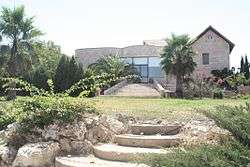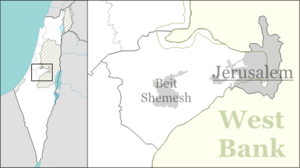Mevo Beitar
Mevo Beitar (Hebrew: מְבוֹא בֵּיתָר, lit. Beitar Gateway) is a moshav shitufi in central Israel. Located ten kilometres south-west of Jerusalem in the Jerusalem corridor, it falls under the jurisdiction of Mateh Yehuda Regional Council. In 2019 it had a population of 965.[1]
Mevo Beitar מְבוֹא בֵּיתָר | |
|---|---|
 | |
 Mevo Beitar | |
| Coordinates: 31°43′20.64″N 35°6′24.11″E | |
| Country | Israel |
| District | Jerusalem |
| Council | Mateh Yehuda |
| Affiliation | Mishkei Herut Beitar |
| Founded | 24 April 1950 |
| Founded by | Beitar members |
| Population (2019)[1] | 965 |
| Name meaning | Beitar Gateway |
History
The village was established near the Betar fortress on 24 April 1950 by native Israelis and immigrants from Argentina who were members of the Beitar movement, including Matityahu Drobles, later a member of the Knesset.[2] It was founded on the land of the depopulated Arab village of al-Qabu.[3] Located around a kilometre from the Green Line, it was a border settlement until the Six-Day War.
gollark: NOOOOOOOOOOOOOOOOOOOOO!
gollark: That's probably right, but I can't be bothered.
gollark: On the other hand, I'll need to make a parser for *this* now.
gollark: Also, mind converting the`"1xminecraft:orange_glazed_terracotta@0"`to `[1, "minecraft:orange_glazed_terracotta", 0]`?
gollark: You finished that just after I made my parser mostly work, incidentally.
References
- "Population in the Localities 2019" (XLS). Israel Central Bureau of Statistics. Retrieved 16 August 2020.
- About Mevo Beitar
- Khalidi, Walid (1992), All That Remains: The Palestinian Villages Occupied and Depopulated by Israel in 1948, Washington D.C.: Institute for Palestine Studies, p. 308, ISBN 0-88728-224-5
This article is issued from Wikipedia. The text is licensed under Creative Commons - Attribution - Sharealike. Additional terms may apply for the media files.